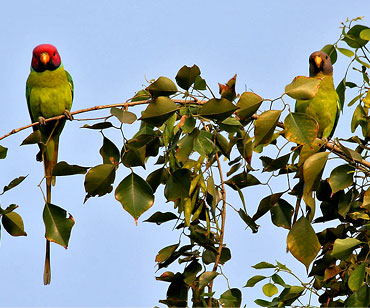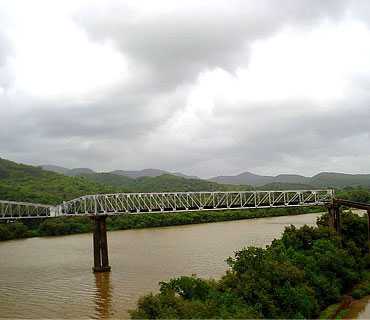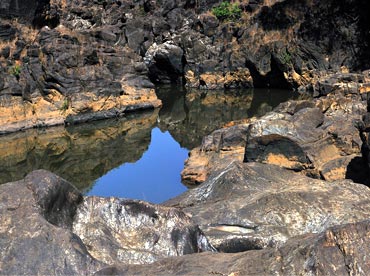 | « Back to article | Print this article |
In the wild: Exploring Goa beyond the beaches
When she visited Goa recently, Lakshmi Sharath decided to give the beaches a complete miss and headed towards the wilderness instead. What followed was a fascinating discovery of slithering snakes and gushing waterfalls.
We were in the thick of the jungle, cutting through the wilderness, occasionally mistaking the creepers for snakes, and pulling out the thorns from our clothes. It was dusk and the shadows darkened as the path grew narrower.
The silence was interrupted by the crickets as we negotiated boulders and trees that blocked us. In the distance we could hear the langurs getting ready to sleep. The darkness of the night soon embraced us as we walked into a different world.
The waters of a nearby stream rushed through the pebbles as we heard a rustle around us.
Suddenly a loud thud and a splash and we stopped dead in our tracks in the darkness.
Our flashlights were out as we saw the massive outlines of the retreating gaurs who had scented our presence in their territory. They glared at us from the trees as we silently observed them and once they decided that we were not there to harm them, they disappeared into the woods.
I was in South Goa but not the Goa we all know. To begin with, the closest beach was at least an hour away. And the only sounds I had heard from morning were the chirping of birds and the occasional call of the langurs.
All roads here led to the wilderness.We were in the midst of the Bhagavan Mahaveer Wildlife Sanctuary lost in the lap of nature and were on a reptile trail in the forests.Lakshmi Sharath is a travel writer and blogger from Bangalore and she blogs at http://backpakker.blogspot.com.
'Suddenly I realised that I was looking at a green vine snake'
We continued walking in the darkness, until Ramesh our guide and an expert at handling snakes pointed to a slender green creeper coiled in the branches of the tree, adjacent to me.
I followed the flashlight he pointed on the plant until it curved out and at the end opened into a small eye.
Suddenly I realised that I was looking at a green vine snake, thin as a tape and although it is believed to be non-venomous, many stories of it falling over people's heads and biting them were heard.
We moved on as Ramesh showed us another poisonous snake, the golden Malabar pit viper curled around a branch, pretending to be asleep only to dart at us, as we inched closer for a photograph.'Here was a Goa that was yet to be explored'
The night stars beckoned us as we returned to our retreat in the forests. I woke up to realise that here was a Goa that was yet to be explored.
Our destination was a small village called Tambdi Surla, except that we realised that the word, village was itself a misnomer.
There were hardly any shops or houses around. There was neither mobile network, nor Internet access nor were there newspapers to connect us with the world outside.
The village had got its name from the 12th century Tambdi Surla Mahadeva temple built right in the heart of the forests flanked by the Western Ghats. And we were headed there after a morning of birding in the forests.
Sipping kokum sherbet and walking around the canopy of fruit trees, I learnt that this was a bird watcher's paradise.
We soon went into the forests for some winged company and the first to greet me was the state bird of Goa -- a bright yellow bulbul with a splash of red around its throat, aptly titled the ruby throated bulbul.'The birds followed us wherever we went'
The jungles burst into a riot of colours. There was a pair of scarlet minivets, several plum headed parakeets, Asian fairy blue bird, crimson backed sunbirds, a black hooded oriole along with Malabar grey and Malabar pied hornbills adding a dash of colour everywhere.
The birds followed us wherever we went. The journey took us right into the heart of the forests where we saw a little stream that was the Rabada river. "Look a snake," a fellow tourist called out and before we knew it, a chequered keelback slithered its way into the waters.
The rivulet I learnt has a journey of its own as it joins another stream to finally empty into the Mandovi. We followed a path that eventually led to the old temple built in the 12th century in a distinct Kadamba-Yadava style.
Lost in the midst of wilderness and surrounded by the Anmod ghats, the Shiva temple was lost to the world. A few locals joined us, as they were getting ready for their temple festival.
They believed that the Pandavas built temple in a hurry and that a cobra was housed in its premises.'We were ready for another trail'
Another night and we were ready for another trail. This time, we were looking for the Jerdon's nightjar, a nocturnal bird that showed itself up for a few seconds as it flew away.
As we looked for owls, we spotted a pair of red whiskered bulbuls huddled together in a bush sleeping away -- a moment that I would probably cherish for a while.
It was dark again when we woke up the following morning. We were driving through the fog towards the River Zuari for a sunrise cruise and boat safari.
The forests seem to engulf us as dense vegetation gives way to gushing streams and backwaters, bordered by cashew plantations and palm trees.
'Soon we lost ourselves in the waters'
Light was just about streaming through the mountains. The only traffic on the road was the never-ending stream of trucks servicing the mining industry. A couple of hills had been denuded as we drove along the forests.
We reached the river, which was bathed in a golden hue. The flying fish jumped around as our boat touched the waters, as we went looking around for the many varieties of kingfishers and several raptors and water birds.
Soon we lost ourselves in the waters, as there was no one around but the birds and us.
'A railway track is high up on the mountain interrupting the falls '
A trip to South Goa is not complete if Dudhsagar Falls is not in your itinerary.
We were warned that it would be a bumpy ride, but we were not prepared for this. As the jeep took us right into the Bhagavan Wildlife Sanctuary, the mud roads opened into a vast expanse of waters. And before we knew it, our jeep was on the waters, rushing through the river and rolling over the pebbles until we reached the jungle roads again.
Rivulets and rivers cross our paths again as we do yet another dance on the waters until we reach the falls. A short hike through boulders and lo the falls greet you!
A railway track is high up on the mountain interrupting the falls and we see a goods train pass by. The walls cascade down into a pool of water, where some foreign tourists enjoy a swim. The waters were inviting and we lost ourselves there.
Goa, paradise for bird watchers and wildlife enthusiasts
Goa is rich in forests. If you are a wild life enthusiast and a birder and are planning a visit to South Goa, then the Bhagavan Mahaveer Sanctuary and Mollem National Park should be on your agenda.
Located in South Goa, near Mollem, the Londa-Mormugao line passes through it and it is about 60 km from Panaji.
We stayed in Nature Nest located right inside the forests at Tambdi Surla, which offers birding, wildlife and heritage tours in Goa.
While this offers a basic accommodation inside the forests, there are other properties like Dudhsagar Spa Resort and Om Shanti Eco Resort, which offer luxury packages.
As these forests are located near the Karnataka-Goa border, you can also find options to stay in Karnataka.
You can also contact Canopy Goa for arranging your tours, irrespective of where you stay. The other wildlife destinations in Goa are in Bondla, Cotigao, Chorla Ghats and Salim Ali Bird Sanctuary .
While it is great to visit any time, the best time to visit for birds is between October and March, while for snakes, it is just before and during the monsoons. Dudhsagar Falls also looks spectacular just after the monsoons.
You can also hike to Tambdi Falls and visit Devils Cannon, a gorge in the wilds with permission from the forest department.Want to share your travel story with us and others around the world? Simply write an email (with the subject line: 'My most memorable vacation') and send it to getahead@rediff.co.in! Also send us pictures of the place you're writing about. We will publish the best ones right here on rediff.com!







